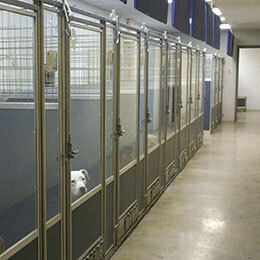Project Profile: Almost Home Animal Shelter

The Challenge
• Install an air handling system that heats and cools while providing superior energy savings.
• Improve indoor air quality for employees and visitors as well as the animals. Eliminate odors by increasing frequency of fresh air changes.
• Remove humidity from frequently washed kennel areas and from incoming outside air during the hot, humid Iowa summers.
• Separate kennel air from office and the community center area to prevent odor infiltration.
The non-profit Humane Society of North Central Iowa opened its new 10,000-square-foot animal shelter with 32 indoor/outdoor kennels in September 2010 in Fort Dodge, Iowa. The new facility replaces two old buildings that had served as the community animal shelter with a combined size of 2,500 square feet.
Although four times the size of the old shelters, the new shelter's annual energy bills for gas and electric are just $16,600 compared to the old shelter's annual bill of $25,000.
The new facility also includes offices, a veterinarian room, a training room and a community center for board meetings, community functions and even birthday parties. The community center space is approximately 1,200 square feet.
Greenheck’s Solution
• (2) Dedicated outdoor air systems with heating, cooling and a total enthalpy energy recovery wheel, Model ERCH
• (4) Ceiling exhaust fans, Model SP
• (1) Inline cabinet fan, Model CSP
Two Greenheck dedicated outdoor air systems with heating, cooling and a total enthalpy energy wheel, Model ERCH, were installed at the new Almost Home Animal Shelter to service the office area and the kennel area separately.
The dedicated outdoor air systems employ total enthalpy energy recovery wheels, modulating supply and exhaust fans, and CO2-based demand control systems for optimum energy efficiency.
Model ERCH combines the benefit of a total energy wheel with supplemental heating and cooling. Fresh outdoor air is preconditioned year-round by the enthalpy wheel, recovering up to 80% of the heating and cooling energy contained in the exhaust air. The enthalpy wheel also removes the humidity from the warm Iowa summer air prior to entering the cooling coil, reducing the overall tonnage required to temper the fresh outdoor air and greatly reducing energy usage.
Factory-mounted variable frequency drives (VFDs), modulated by CO2 levels, further enhance the unit's efficiency by only delivering the required amount of outdoor air to the space.
Ceiling exhaust fans and an inline cabinet fan were installed to remove stale air from all areas as well as excessive moisture from the frequently washed kennel area ensuring fresh, comfortable, odorless air for both human inhabitants and the animals.
The Results




